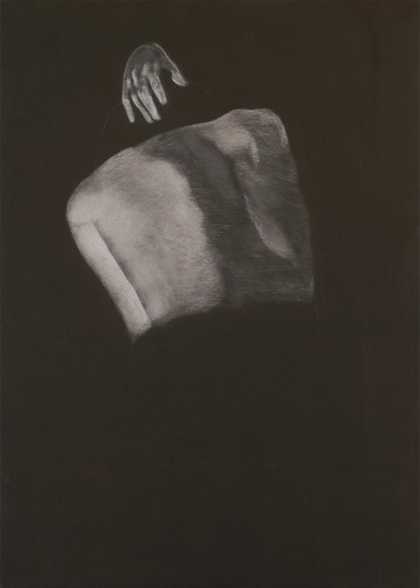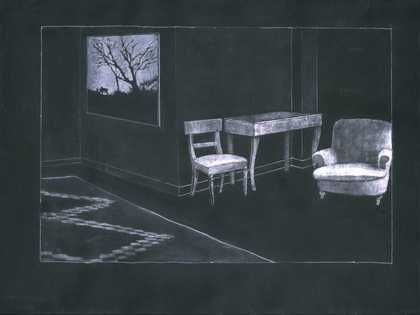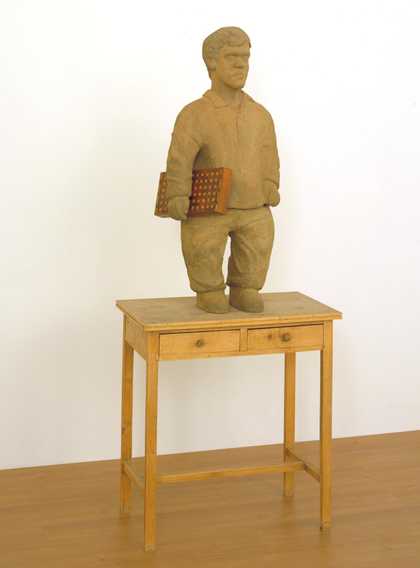Juan Muñoz described himself as a storyteller, and often arranged his figures and objects in carefully staged configurations that hint at unsettling and ambiguous scenarios. One of the last things he made before his untimely death in 2001 at the age of 48 was a vast stage-set-like installation for Tate Modern's Turbine Hall.
Curator Sheena Wagstaff offers an overview of the exhibition.
Juan Muñoz, who was born in 1953, was the first of a new generation of Spanish sculptors to emerge in post-Franco Spain. He came to prominence in the 1980s with a sculpture that was quite different from what was going on at that point. He was brave enough to embrace the figure, but he was also very interested in the idea of sculpture and realism, and how near it could come to being a realistic facsimile of the world we know, but actually then slips away from us. So it really is this Borgesian notion of a kind of slippage between fact and fiction that he engaged with. As part of one of the themes of Juan’s work, the drum reappears again and again in his work. It’s a sort of thing that he returns to. And one of his earliest works shows a drum which is made of wax, through which a pair of scissors has been plunged through the skin – the top skin. And there is an analogy, of course, between the drum and the ear, because the drum skin is analogous to the tympanic membrane, and of course when you pierce it, you prevent or stop the possibility of hearing. That’s a very clear message, I think, that comes through the work. But what is less known, and what he was absolutely fascinated by, was the fact that speech cannot happen unless hearing exists, which is why in the 19th century before technology allowed hearing aids to happen, or cochlea implants, people who didn’t hear themselves speak could not therefore create sound. That’s a very important part of what these figures are about. One of the earliest pieces, a sort of key iconic work, is The Wasteland, where there is a little ventriloquist’s dummy sitting on a very low shelf above an extraordinary expanse of floor, which is an optical illusionistic floor, so when you walk on it and you look at it, and if you are walking across the floor and you are looking down, it can be actually very unsteadying. When you go to the hub of this exhibition, which is a piece called Many Times, in which there are a hundred figures, where these figures are extraordinarily expressive. Despite the fact that their physiognomies are absolutely the same, you can by placing them as I have done – and they can be placed in any way possible – but where there is obviously a kind of an interaction or communication between them implied, you are always, as a visitor, excluded from these groups. Not only that, but because they are lower than life-size, when you are watching other people move through the sea of characters, you realise that actually the visitors are the anomaly, not the figures themselves. A lot of Juan’s work, most of it, depends not just on the usual exhibition kind of lighting, but on lighting that really does pick up the surface quality of these sculptures. One of the works that is very obviously one where light then actually creates another figure, is a figure called Towards the Shadow, where there is one of his figures standing almost on tiptoe with both arms out by his side, almost being blasted back by looking at this humongous shadow that looms above him. In fact it’s his shadow, that’s very cannily lit from behind. And this shadow then becomes not just another figure, but also a rather ambiguous alter ego. And there are many points in the exhibition where the shadow of a work or the implied lack of light then creates a different kind of installation. The hanging figures are primarily influenced by Edgar Degas’ acrobatic figure in the circus called Miss Lala. But there is a difference to these figures because Juan’s figures are suspended by what looks like instead of holding, as a circus acrobat would do, a clamp between her jaws, which is what Miss Lala did, these figures almost have a tongue that is sort of elongated and pulled out in a very cruel, tortuous way from their mouths. It’s an extraordinary image of a combination of extreme violence, pain and also vulnerability. Another key theme of Juan’s work is the mirror; but of mirroring, rather than the mirror itself. The mirror represents, for Juan, the ability to create what he calls the grand illusion – a pictorial illusion. And it is that illusion, that bringing together of an artistic world alongside the world in which we stand, that interests him. So when we catch glimpses of ourselves in some of the pieces which use mirrors and we are implicated into that world, it is almost like Alice through the looking-glass, and that is really what he intends to do.





